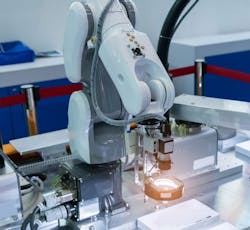Buying industrial machines can quickly bite into a company’s capex budget, so many manufacturers are delaying purchases by extending equipment lifecycles with new control hardware or data acquisition options. The goal is to future-proof machines into the next decade and optimize plant floor operations as manufacturers wrestle with industry shifts.
Particularly with the emergence of lightweight data acquisition systems, many companies view overall equipment effectiveness (OEE) and key performance indicator (KPI) visibility as low-hanging fruit. An example of a company addressing this trend is The Aquila Group and its use of Opto 22’s SNAP PAC control platform and groov appliance to implement data visibility systems for sheet metal machines at a variety of manufacturers, including Kohler, Fiat, Eaton Electrical and Siemens.
To drive lean manufacturing for these manufacturers, The Aquila Group created the Green Light Monitoring System that gathers machine-level data for OEE measurement and feeds this data to its own Dynamic Machine Management (DMM) manufacturing execution system (MES).
The Green Light Monitoring System polls the controller for electrical signal values and control system variables, and then translates these values into information about the machine such as machine state, speed, downtime, alarms and other KPIs.
“My preferred method for data acquisition from PAC systems is to simply read all contents of memory in a single read and parse once on the PC side,” says David Wilmer, Aquila’s vice president of manufacturing systems design. “This minimizes network traffic, a key consideration to existing infrastructure, and provides a complete picture of input/output states in real time.”
The monitoring system provides an activity logging system that collects signals and alarms for automatic and manual reporting of downtime events. The system offers many types of KPI options and companies can integrate their internal metrics, such as micro stops.
“We developed a system so customers can define a micro stop from their perspective,” Wilmer says. “Most companies are aggressive, and micro stops are considered anything from one to five minutes, at the outside.” Wilmer also points out that many companies log “unclassified micro stops” as a machine stop under a defined threshold. “The higher this total rollup becomes over a given period, it can point to the need to become more aggressive with minimum thresholds to collect greater resolution to micro outages.”
Typical manufacturing systems supported by The Aquila Group range from a few I/O points monitored on a single machine up to much larger installations with more than 3,000 I/O points across more than 70 machines with direct OPC interaction.
The logging system uses downtime reason codes at work centers, and operators add from a defined list of codes to indicate the root cause of downtime. Many customers—with bidirectional communication options from the plant floor—are demanding more detail on downtime to provide more context. “An operator can add a narrative to provide further explanation of what happened,” Wilmer says. “If a rear gate unexpectedly opens, the operator may write: Rear gate alarm created a micro stop; real gate switch bad; added temporary support for switch to get through shift; maintenance needs to access and replace ASAP.” Other features include the ability for the logging system to create cascading, engineering questions when a machine passes its threshold and enters into a micro stop scenario.
The monitoring system also comes with the ability to customize screens via Opto 22’s groov appliance via custom tags. The monitoring software provides alerts to operators and engineering staffs via smartphones or plant floor screens while escalating production outages to management after a specified amount of time.
Enterprise connection
Besides presenting OEE and real-time parameters on the plant floor, Aquila integrates machine product data to enterprise resource planning (ERP) systems via the company’s DMM software to promote full demand-pull practices—lean manufacturing tenets.
The DMM software affords many options to receive an order from different types of ERP systems, such as traditional text files, JSON objects, RESTful API calls or custom-written web services. “With our software, we provide accurate information about the amount of labor, material usage, machine usage and scrap loss for a given part,” Wilmer says.
The DMM software also can be used as a standalone MES and works with control punch, laser, press brake, weld area, machining, paint, assembly and general production work cells.
Aquila can also connect legacy sheet metal machines without modern programmable logic controllers (PLCs) and Ethernet. “We operate our own controls shop and can support a legacy machine by designing our own control system utilizing Opto 22 hardware,” Wilmer says. “We grab the discrete points either via wired or wireless signals and give data visibility to a machine that never had it from the factory.”
The steps being taken by companies like The Aquila Group illustrate how comprehensive data visibility in the plant is hitting its stride as more manufacturers understand the opportunity for the resulting operational efficiency gains and how quickly these systems can be implemented.
About the Author
Grant Gerke
Digital Managing Editor

Leaders relevant to this article:
